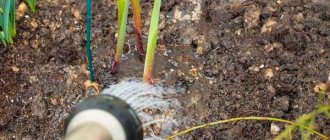A flower such as Aubrieta is also called aubrieta. It is related to a genus of creeping evergreen herbaceous flowering plants that are perennials and belong to the cabbage family. This genus includes about 12 species. This flower is cultivated in rock gardens, as well as in all European countries as a garden plant. Under natural conditions, aubrieta is found in Italy, Asia Minor, the southern part of France, as well as in South America, where it prefers to grow on river banks and rocks. The Latin name was given to the plant in honor of the Frenchman Claude Aubrier, who was an artist and worked in the genre of botanical illustration. In Russia, such a flower is called a windbag. During flowering, this plant looks like a spectacular continuous carpet. This flower has one peculiarity: its beautiful leaves do not fade even in winter.
Features of the aubrieta
Small alternate leaf blades have pubescence and an obovate or elliptical shape. Their edges are jagged or solid. Few-flowered, racemose inflorescences consist of small four-petaled flowers with a centimeter diameter and a purple, blue, violet or pink-red color. Flowering is abundant and lasts from the second half of spring until the beginning of summer. If you provide proper and good care, then in the autumn the aubrieta can bloom again. The fruit looks like a pod containing flat brown seeds.
Below we will describe how to properly plant, grow and propagate such a flower. And also how to protect against harmful insects and diseases.
Awesome perennial - Aubrieta. Flowering, care and methods of reproduction.
General description, photo of flowers
Aubrieta is a member of the Cruciferous (Cabbage) family. The natural distribution area is Asia Minor, countries in southern Europe and the South American continent. In cultivation, wild varieties are practically not used due to the large number of artificially bred ornamental varieties. It is an evergreen ground cover, whose favorite places to grow are rocky river banks. Aubrieta flowers are small, about 1 cm, and in themselves ineffective, but due to the abundant flowering, the curtain looks very bright and picturesque, like colored pillows, repeating the terrain. The coloring of the basic varieties is laconic - white, pink and blue-violet, but numerous varietal lines greatly expand this range due to interesting shades, halftones and transitions.
The leaves of aubretia are also particularly decorative - slightly pubescent, small in size, sometimes edged with colored gold. The arrangement is regular, the shape is elliptical or obovate.
The height of the ground cover is usually no more than 30 cm in the center of the curtain. Flowering begins early, immediately after primroses and lasts 1-2, rarely 3 months. The fruit is a pod with flattened brown seeds.
With quality care, some types of aubrieta can re-bloom closer to autumn.
Growing aubrieta from seeds
This plant is quite easy to propagate by seeds, and it can be grown either through seedlings or without seedlings. But if the seeds are sown directly in open soil in September or May, this may result in the splitting of the varieties. In this regard, experts recommend growing aubrieta exclusively through seedlings. The flowering of such a plant grown from seeds can only be observed in the second year of life. Aubriet seeds are sold in all specialty stores.
Seeding
Sowing is done in the last days of February, approximately 8–10 weeks before the onset of heat. Sow the seeds of such a flower immediately into separate pots. To do this, you can use peat-humus pots or peat tablets; seedlings are planted in open ground directly in these containers. First, moisten the substrate of the pot or tablets, and then place 2 or 3 seeds on its surface. They should be sprinkled on top with a thin (0.3–0.5 cm) layer of sand. Moisten the sand with a fine spray bottle, and then place the containers under glass or film. The best air temperature for sowing is 18–21 degrees.
How to care for seedlings
Caring for seedlings is very simple. So, they need to be ventilated every day, and also watered when necessary. The first seedlings can be seen after 20–30 days, after which the shelter must be removed completely. The plant must be watered very carefully, because the seedlings react extremely negatively to an overly moistened substrate. If the seedlings are weak and their development is slow, it is recommended to fertilize with complex mineral fertilizer half a month before planting in open soil, and the concentration of the solution should be weak.
Aubriet flowers. Growing through seedlings.
Picking
Aubrieta reacts extremely negatively to transplantation; therefore, when growing through seedlings, picking is not done. That is why the seeds of this plant are recommended to be sown in separate containers (more about this is described above).
Varieties of aubrieta as a garden flower
There are a total of 12 species of this beautiful flower. The color scheme is replete with variety - from white to purple or blue. There are hybrid or cultural aubrieta and deltoid beauty. Now a detailed story about each of these species.
The deltoid or deltoid aubrieta is popularly called the “lilac bush”; due to its purple color, from a distance it resembles a lilac twig. The homeland of this variety is South-Eastern Europe, only there you can find this plant in natural conditions. This variety of this plant, with proper care, reaches a height of 15 cm.
The second common type of this flower is the cultivated (hybrid) aubrieta, which is an early variety. It is a green subshrub that reaches a height of up to 20 cm.
Breeders have developed hundreds of varieties of this species: the bright blue Blue King, the spherical Red King, the sky-blue Cote d'Azur and other plants of indescribable beauty.
Planting aubrieta in open ground
What time does disembarkation take place?
It is recommended to plant these flowers in open ground only after the threat of frost has passed, and as a rule, this time falls in the second half of May. The site for planting must be chosen carefully. When choosing a site, you should take into account that for aubrieta to bloom abundantly and incredibly spectacularly, it needs the maximum possible amount of direct rays of the sun. When choosing soil, you should take into account that such flowers grow and develop better, the poorer the soil on the site. So, this plant grows well between concrete slabs and stone steps. However, it is worth remembering that the soil needs to be loose, well permeable to water, and its composition should include a small amount of peat or ash. It is also best if the soil is neutral or slightly alkaline pH 6.0–7.0.
How to plant correctly
A flower like aubrieta is considered by gardeners to be very flexible. In this regard, it can be planted exactly as you would like, and you can create a rock garden or flower bed of any shape. The depth of the planting hole depends on the length of the roots of the seedling, and its width should be 2 times the width of the pot in which the aubrieta grows. When planting, it should be taken into account that the distance between the bushes should be at least 5 centimeters. If your flower grew in a container made of ceramic or plastic, then immediately before planting the pot must be completely immersed in water. Wait until air bubbles begin to emerge from the soil. After this, carefully remove the plant along with the earthen lump and place it in the prepared hole. When the plant is planted, the soil will need to be compacted, its surface covered with mulch (a five-centimeter layer of sand), and then carefully watered.
7.Use in landscape design
Aubrieta is ideal for the rocky slopes of alpine hills - this flower withstands the lack of nutrients in rocky soil and does not tolerate excess moisture.
Often these plants are used in the landscape as ground cover - they form a dense grass mat, completely buried in buds.
Extremely interesting is the ability of the root system of this flower to attach itself to any surface, including cracks in brickwork. Bushes that accidentally grew in this way on the wall are used for vertical gardening.
Aubrieta is good as a border plant - the bushes can serve as an edging for flower beds and flower beds.
Plants with long, drooping shoots are often used as hanging plants - they are grown in hanging baskets and flowerpots.
Due to the fact that the green leaves remain on the bushes during the winter months, this perennial will become one of the first decorations in the flower garden, long before other plants turn green.
You can grow plants in flowerpots and move them to any desired location. Bushes near the water look interesting - they can be placed along the banks of a garden pond.
Irreplaceable in balcony gardening - the bushes will delight their owners with lush blooms even in cramped pots.
↑ Up,
How to take care of the garden
Watering
Caring for aubrieta is very simple and it will not take much of your time. Once the flowers are mature, they need to be watered only when there has been a sufficiently long dry period. In the same case, if you water the aubriet often and a lot in the usual summer weather, then you risk provoking rapid growth of greenery, while the flowering will be relatively sparse. Young specimens need to be watered more often than older ones, but even in this case you should be quite careful. It is recommended to water using sprinkling. After the shavings have been watered or it has rained, the surface of the soil must be loosened, and all weeds must be pulled out.
Fertilizer
During the period of active plant growth, it is recommended to sprinkle the surface of the area with mulch 2 or 3 times. For this, sand is used, and the layer thickness should be from 3 to 5 centimeters. Aubrieta is fed with a solution of complete mineral fertilizer for perennial flowering plants. In this case, fertilizing is carried out in the spring before flowering begins, as well as in the fall.
Trimming
After the aubretia fades in the spring, it must be cut back almost to the level of the ground surface. In this case, the active growth of young stems with richly colored leaves will begin. Against the background of the aubrieta, other flowering plants will look simply excellent. After some time it will bloom again.
How to propagate
Planting and growing aubretia is quite simple, the main thing is not to forget the basic rules for caring for it. It can be propagated very easily by cuttings and seeds. How to grow such a flower through seedlings is described above. However, gardeners who have a lot of experience sow aubrieta directly into open soil. Before sowing seeds, the soil must be prepared. To do this, it is dug up to a depth of 15 centimeters, all stones and weeds are removed, complex fertilizer, chalk (lime) and wood ash are added, and then moistened. Seeds should be placed directly on the surface of the ground, but they should not be sown too thickly. There is no need to bury them, just pour a layer of sand on top of the seeds, the thickness of which should be from 3 to 5 centimeters. Then the crops need to be watered very carefully using a watering can. If sowing was done in the spring, then the first seedlings will appear in 1.5–3 weeks, and if in September, then only when the next spring comes.
It is also quite easy to propagate this plant from cuttings. In the middle of the summer period, this flower is pruned, after which you will have a large amount of planting material. You can use cut shoots that have no flowers as cuttings. They need to be planted in a greenhouse in a soil mixture that includes sand and peat (1:1). At the end of summer, the rooting of the cuttings should be completed, and they can be planted in a permanent place in open ground. Before the onset of winter cold, young plants take root well and become strong. If in your area there are very severe frosts in winter or there is little snow at this time of year, then the cuttings can not be planted in open ground, but left in a greenhouse until spring.
The flower can also be propagated by dividing the bush. It is best to carry out this procedure in spring or autumn. Aubrieta does not tolerate this kind of reproduction very well, which is done quite simply. To do this, you need to dig up a bush and divide it into several parts, with each division containing roots and well-developed stems. After this, the divisions are planted in separate holes. But it should be borne in mind that all your efforts may be completely in vain, and the aubrieta transplanted using this method may well die. Therefore, experienced gardeners prefer to resort to seed propagation or cuttings.
Diseases and pests
Aubrieta has a relatively high resistance to various diseases and harmful insects, so it is quite easy to care for it. In some cases, the plant may become infected with powdery mildew, and a whitish coating appears on the leaf blades and flowers. This disease is a fungal disease, and as it develops, this plaque becomes brown in color. A bush infected with this disease loses its spectacular appearance, and its growth becomes slower. The affected parts of the flower turn black and die, while the bush itself becomes much less winter-hardy. To treat powdery mildew, you can use colloidal sulfur, following the instructions on the product package.
The greatest danger of all harmful insects to aubrieta is aphids. This is a sucking insect that uses plant sap as food. Aphids are spreaders of dangerous viral diseases. You can get rid of such harmful insects with the help of Karbofos, Biotlin, Fufanon or Arrivo. Depending on the degree of infection of the bushes, 1–4 treatments may be needed.
In general, such a flower, which prefers to grow between stones, rarely gets sick.
Propagation using cuttings
After pruning at the end of the first flowering, a lot of planting material remains in the form of green cuttings. Trimmed parts of shoots can be rooted in water or in a peat-sand mixture in greenhouse conditions. By the end of August they will have produced roots and will be ready to be transplanted to a permanent location. You cannot delay planting, since the root system is very vulnerable.
In regions with very cold winters, it is recommended to plant the cuttings in disposable cups and keep them in them until spring at home, after which transplantation is carried out by careful handling.
With regard to aubrieta, the vegetative method of propagation by dividing the bush is unacceptable, since the plant will most likely die after this.
How to care for perennial shavings after flowering
Collecting seeds
When propagating such a flower with seeds collected independently, you need to remember that they may not retain all the varietal characteristics of the parent plant. However, if you still want to collect the seeds, then when the aubrieta fades in the spring, you need to leave 2 or 3 stems with ovaries during cutting. Wait until the seeds turn dark and carefully trim the pods. Hull them, and bring the seeds indoors and ripen them. These seeds can be sown before winter in the same way as described above.
Preparing for winter
After spring flowering, experts advise be sure to cut off all the stems of this plant. However, after the end of the second flowering there is no need to do this. The stems and flowers should be left throughout the winter, and they will need to be cut only with the onset of spring. These perennial flowers tolerate winter very well without shelter. But it should be taken into account that if the winter is too harsh and there is little snow, then the aubrieta may well die; therefore, experienced flower growers recommend covering the flowers with a layer of dry foliage or covering them with spruce branches.
Useful tips to help the gardener
Areca chrysalidocarpus features of care and cultivation
It cannot be said that growing aubrieta is a simple matter, but there is nothing complicated in the process either. The main thing is to use a few tips that can please the gardener with lush flowering.
So:
- Aubrieta prefers spacious territories;
- any shading of the plant has a detrimental effect on the entire flower colony;
- Aubrieta prefers irrigation by sprinkling;
- excess moisture provokes poor flowering and abundant foliage;
- during plant growth, only one or two feedings are required;
In order to grow a truly rich flower colony, fertilize the soil twice, namely: the first time immediately before sowing the aubrieta. The second feeding should follow the pruning procedure, which is carried out after the end of the flowering period to produce another wave of flower cover, as shown in the photo on the right (just above).
Don't be afraid of pruning the plant. Quite quickly, the aubrieta will produce new shoots. Eliminating this part of the care will not ensure a full-fledged process, and growing a flower will not give the much-anticipated joy from all the work done.
The good thing about choosing aubrieta is that the plant will bring many pleasant moments to the gardener. A particularly beautiful variety is called enchanting Morocco. You can see what this plant variety looks like in the photo on the left.
You will learn more detailed information about the flower from the video attached to the article:
Varieties and types of aubrieta with photos and names
There are 12 natural species of aubrieta, some of which are grown by gardeners. It is quite rare to find such species in gardens of middle latitudes as: white aubrieta, Croatian aubrieta, graceful aubrieta, Kolumka aubrieta. However, there are types that are more popular, and they will be discussed below.
Aubrieta deltoidea, or deltoid aubrieta
The height of this herbaceous perennial plant can reach 15 centimeters. The greenish-gray deltoid-shaped leaf blades have 1 or 2 cloves on each edge. Loose racemose inflorescences consist of small flowers (diameter about 10 millimeters), which are colored lilac or blue-purple. In May, aubrieta begins to bloom. The duration of its flowering is a little more than 4 weeks. This species has been cultivated since 1710 and is popularly called the “lilac bush.” He has a variety of Bougainvillea, the height of its bush reaches 20 centimeters, the flowers are pale lilac, with an orange center. Thanks to breeders, the cultivated aubrieta species was born, which is the most popular among gardeners, and they took the deltoid aubrieta as a basis.
Cultural aubrieta (Aubrieta x cultorum), or hybrid aubrieta
This is a group of plants that do not exceed 20 centimeters in height and are able to overwinter under snow cover. The small leaves are oblong in shape and have jagged edges. The diameter of the purple or lilac flowers reaches 1 centimeter. Today, various varieties of this species can have semi-double, double and simple flowers. They can be easily propagated by seed. There are varieties that can be grown in pots at home, and there are also ones suitable for cutting.
The most popular varieties of cultivated aubrieta:
- Cascade. The flowers of this perennial can be purple, pink, blue, turquoise or red, and they have a small yellow center. The greenish-gray leaf blades have the same color throughout the year.
- Enchanting Morocco. The bush is lush and very impressive. The flowers are relatively large in size (about 15 mm in diameter). Their color can vary from pink and red to blue.
- Cote d'Azur. This plant has very beautiful azure-colored flowers. Flowering continues for 2 summer months. In September, repeated flowering is observed, which continues until the onset of winter frosts.
- Giant waterfall. This is a variety mixture that includes plants of various colors, namely: pink, lilac, violet, red, etc. The height of such a winter-hardy perennial plant does not exceed 15 centimeters. The flowers have a centimeter diameter.
Gardeners also enjoy cultivating such varieties of aubrieta as: Carnival, Doctor Mules, Don, Gloriosa, Wanda, Blue King, Queen, Royal Cascade, Triumphant, etc.
Diseases and pests
The plant is immune to viral and fungal diseases. It has only one enemy - overwatering the soil, which leads to rotting of the root system and the formation of gray rot. If not properly cared for, the plant may be susceptible to attack by aphids.
If you follow all the rules of care when growing, it will not be afraid of either diseases or insects.
Growing perennial aubrieta is not only simple, but also very interesting. To get a chic flower carpet, you need to give this wonderful flower a little care and attention, and then it will thank its owner with lush and long-lasting flowering.
When to sow aubrieta for seedlings in 2021 according to the lunar calendar?
Gardeners and gardeners know that plants sown in certain phases of the moon have high germination and growth energy. Every year, scientists compile a Lunar calendar to help farmers, which identifies favorable and dangerous days for sowing and other work.
Favorable days for sowing aubrieta in 2021, depending on the month
- In February, it is recommended to sow aubriet on the 12th, 13th, 14th, 15th, 16th, 17th, 18th, 19th, 20th, 21st, 22nd, 23rd, 24th, 25th, 26th. The moon these days is in a phase favorable for flower growth. The plants will sprout quickly and amicably, and there will be little pain.
- Favorable days for sowing aubrieta in March will be: 14, 15, 16, 17, 18, 19, 20, 21, 22, 23, 24, 25, 26,27
- Favorable days for sowing and growing seedlings in April : 13, 14, 15, 16, 17, 18, 19, 20, 21, 22, 23, 24, 25,26.
- In May , some gardeners sow aubration directly into the ground; days for planting: 12, 13, 14, 15, 16, 17, 18, 19, 20, 21, 22, 23, 24, 25.
Unfavorable days for planting and growing aubretia in 2021
You should not sow aubretia seedlings on the New Moon, Full Moon and days when the moon is in Aquarius:
- 10, 11, 27
February; - 9. 10, 11, 13, 28 Martha;
- 6,7, 12, 27 April;
- 3, 4, 11, 26 May inclusive.
On these dates there is a New Moon or Full Moon, which negatively affects plant life.
Reproduction methods
Sprekelia - cultivation and care in open ground
Most often, aubrieta is propagated by seeds or cuttings. Dividing the bush is rarely chosen; the roots of the plant are so fragile that they should not be touched again.
Cuttings usually remain after regular pruning of the bush. Shoots without flowers are placed in a mixture of sand and peat. It is necessary to create greenhouse conditions for them, and after rooting, transfer them to open ground. Typically, transplantation is planned for late summer or early autumn.
Further care of ornamental crops
How lush the aubretia carpet will turn out depends on further care of the plant.
Watering
Care must be taken when moistening aubrations. The flower does not like too wet soil and will react with rotting of the roots or lack of flowering. If there is sufficient natural precipitation, this procedure is abandoned, and watering is carried out only during particularly dry periods. Moreover, the best option for the plant is considered to be the sprinkling method.
Fertilizer
Fertilizing is the key to abundant and long-lasting flowering of aubretia. It is carried out twice a season, using mineral compounds. Flowers are fertilized for the first time in the spring, at the stage of bud formation. A second feeding is necessary for the shave in the summer, after the pruning procedure, in order to stimulate a second wave of flowering.
Trimming
This procedure is necessary for the plant to bloom again. It is carried out after the first wave, which lasts up to 7 weeks. All stems are cut at the root and mineral supplements are applied. After this, the flower actively begins to grow and by autumn it pleases the owners of the site with a new wave of abundant flowering. In the fall, before preparing for winter, pruning is no longer carried out, otherwise the plant may die in the cold season.
Preparing for winter
Aubrecia is famous for its increased frost resistance and winters in open ground without problems. Only in the northern regions are dry leaves thrown on top of the bushes and covered with spruce branches.
Advantages and disadvantages
The advantages and disadvantages of ground cover crops are the point that gardeners first pay attention to when choosing a variety for their site.
The advantages of the flower include:
- The spectacular appearance of a blooming carpet.
- Low maintenance requirements.
- Richness of color palette.
- Resistance to low and high temperatures.
- Ease of reproduction.
See also
Planting and caring for jasmine, propagation of shrubs, pruning and replantingRead
There are practically no disadvantages to aubration:
- Requirements for lighting.
- The need to replant every two years.











